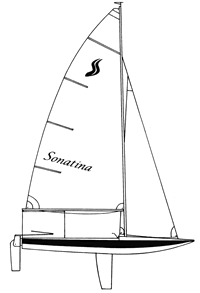Sonatina
One-design/daysailer
This handsome little scow has an interesting history and rather than regurgitate it for you I think I'll let Chris Koper, the designer and a veteran Finn sailor, tell it himself:
"My father, Jack Koper, conceived the predecessor design, the Sonnet, of which more than 500 have been built in South Africa. The Sonnet was based on the stunning success of the very popular 12-foot Dabchick, a junior trainer that is fleet of foot, yet stable and great fun to sail. That class numbers more than 5,000, and it is still very active; every well-known South African sailor learned to sail and race on a Dabchick. The Sonnet was also derived from the 15-foot Tempo, aimed at the more expert sailor with trapeze and spinnaker.
"When Jack died three years ago I went to be with the family. The weekend after his passing I attended the annual Interschool Regatta and was invited to present the trophy to the winning school team. That gave me an opportunity to tell the latest crop of juniors about how these speedy boats originated when their parents were learning to sail.
"The Interschool event has been run for more than 40 years, and I was one of those who sailed in it back in the late 1950s. The Dabchick has been the core of the event every year since then; today the lineup also includes the Sonnet and the Optimist. I saw then that the Sonnet was also an ideal boat for junior sailing.
The Sonatina is my way of recognizing the amazing influence Jack had on so many lives, and of course my own. I am taking his legacy a step further by offering North Americans a way to build a wonderful boat and go sailing with the Sonatina. The big advantage is that this enjoyable boat can be built at home with a low level of technical difficulty.
"There is 12 percent more sail area than the Sonnet for more power, and the higher aspect ratio of both the rig and the foils contribute to sparkling windward performance. I narrowed the beam to reduce the wetted surface, then deepened and angled the sides to allow more heeling. That allows one to raise the windward side out of the water and further reduce drag. I then induced a compound double-curve to the bottom panels to provide sweeter lines, and again cut down on wetted surface and drag.
"The prototype is built in plywood covered with epoxy glass for strength and durability, just like the Chesapeake 18 sea kayak I built in the spring. The boat looks stunning in its coat of glossy varnish.
"The hull weighs in at 140 pounds, so it has the advantage of being very quick to plane and it's a lot faster reaching than similar sized dinghies. Compared with Midwest scows, the Sonatina has a much lower displacement, and the V-bottom creates a better hull shape. It's a great feeling to skim over the waves at speed. Juniors and novices enjoy the performance and get hooked quickly."
There are some interesting points that Chris did not mention. The sa/d is a healthy 35.5 if you assume a crew weight of 220 pounds. (I figured one 120-pounder and a 100-pounder.) And there will be an additional rig available soon that provides a more flexible mast for singlehanding, allowing the single sailor to bend the mast to flatten and depower the main. Note that when you heel the Sonatina between 10 and 15 degrees you get the leeward bottom panel about flat with the water, which makes the boat quite stable.
This shapely little rocket would make an excellent family winter project, not to mention a wonderful family dinghy.
A dinghy with a history and horsepower that you can build yourself.

Comments